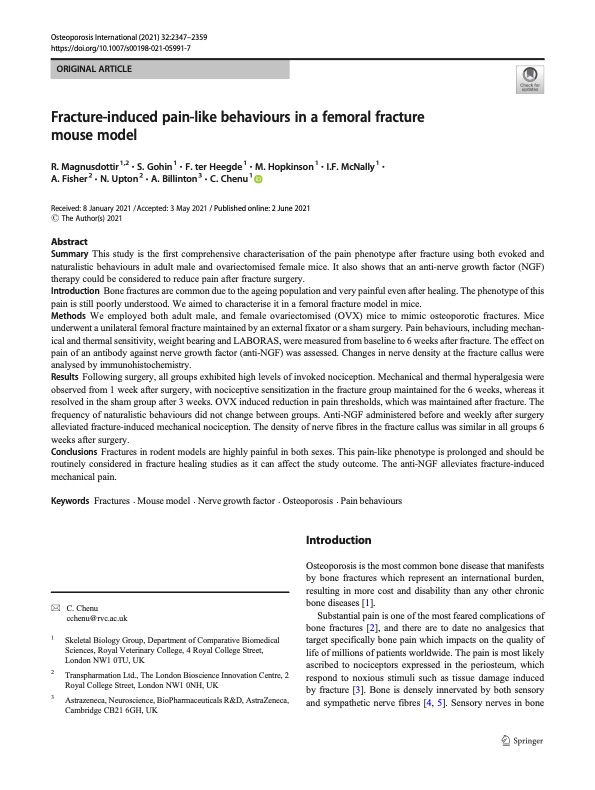R Magnusdottir
Fracture-induced pain-like behaviours in a femoral fracture mouse model
Magnusdottir, R; Gohin, S; ter Heegde, F; Hopkinson, M; McNally, IF; Fisher, A; Upton, N; Billinton, A; Chenu, C
Authors
S Gohin
F ter Heegde
M Hopkinson
IF McNally
A Fisher
N Upton
A Billinton
C Chenu
Abstract
This study is the first comprehensive characterisation of the pain phenotype after fracture using both evoked and naturalistic behaviours in adult male and ovariectomised female mice. It also shows that an anti-nerve growth factor (NGF) therapy could be considered to reduce pain after fracture surgery. Introduction Bone fractures are common due to the ageing population and very painful even after healing. The phenotype of this pain is still poorly understood. We aimed to characterise it in a femoral fracture model in mice. Methods We employed both adult male, and female ovariectomised (OVX) mice to mimic osteoporotic fractures. Mice underwent a unilateral femoral fracture maintained by an external fixator or a sham surgery. Pain behaviours, including mechanical and thermal sensitivity, weight bearing and LABORAS, were measured from baseline to 6 weeks after fracture. The effect on pain of an antibody against nerve growth factor (anti-NGF) was assessed. Changes in nerve density at the fracture callus were analysed by immunohistochemistry. Results Following surgery, all groups exhibited high levels of invoked nociception. Mechanical and thermal hyperalgesia were observed from 1 week after surgery, with nociceptive sensitization in the fracture group maintained for the 6 weeks, whereas it resolved in the sham group after 3 weeks. OVX induced reduction in pain thresholds, which was maintained after fracture. The frequency of naturalistic behaviours did not change between groups. Anti-NGF administered before and weekly after surgery alleviated fracture-induced mechanical nociception. The density of nerve fibres in the fracture callus was similar in all groups 6 weeks after surgery. Conclusions Fractures in rodent models are highly painful in both sexes. This pain-like phenotype is prolonged and should be routinely considered in fracture healing studies as it can affect the study outcome. The anti-NGF alleviates fracture-induced mechanical pain.
Citation
Magnusdottir, R., Gohin, S., ter Heegde, F., Hopkinson, M., McNally, I., Fisher, A., Upton, N., Billinton, A., & Chenu, C. (2021). Fracture-induced pain-like behaviours in a femoral fracture mouse model. Osteoporosis International, 32(11), 2347-2359. https://doi.org/10.1007/s00198-021-05991-7
| Journal Article Type | Article |
|---|---|
| Acceptance Date | May 3, 2021 |
| Publication Date | 2021 |
| Deposit Date | Nov 29, 2021 |
| Publicly Available Date | Nov 29, 2021 |
| Journal | Osteoporosis International |
| Print ISSN | 0937-941X |
| Electronic ISSN | 1433-2965 |
| Publisher | Springer |
| Peer Reviewed | Peer Reviewed |
| Volume | 32 |
| Issue | 11 |
| Pages | 2347-2359 |
| DOI | https://doi.org/10.1007/s00198-021-05991-7 |
| Keywords | Fractures; Mouse model; Nerve growth factor; Osteoporosis; Pain behaviours; ORTHOPEDIC-SURGERY; NERVE-FIBERS; BACK-PAIN; BONE; OSTEOPOROSIS; BLOCKADE; MANAGEMENT; ANTIBODY; WOMEN |
| Public URL | https://rvc-repository.worktribe.com/output/1552940 |
Files
OA
(140 Kb)
Image
You might also like
Expression of semaphorin-3A in the joint and role in osteoarthritis
(2024)
Journal Article
Bone marrow lesions: plugging the holes in our knowledge using animal models
(2023)
Journal Article
What Did We Learn About Fracture Pain from Animal Models?
(2022)
Journal Article
Downloadable Citations
About RVC Repository
Administrator e-mail: publicationsrepos@rvc.ac.uk
This application uses the following open-source libraries:
SheetJS Community Edition
Apache License Version 2.0 (http://www.apache.org/licenses/)
PDF.js
Apache License Version 2.0 (http://www.apache.org/licenses/)
Font Awesome
SIL OFL 1.1 (http://scripts.sil.org/OFL)
MIT License (http://opensource.org/licenses/mit-license.html)
CC BY 3.0 ( http://creativecommons.org/licenses/by/3.0/)
Powered by Worktribe © 2025
Advanced Search

